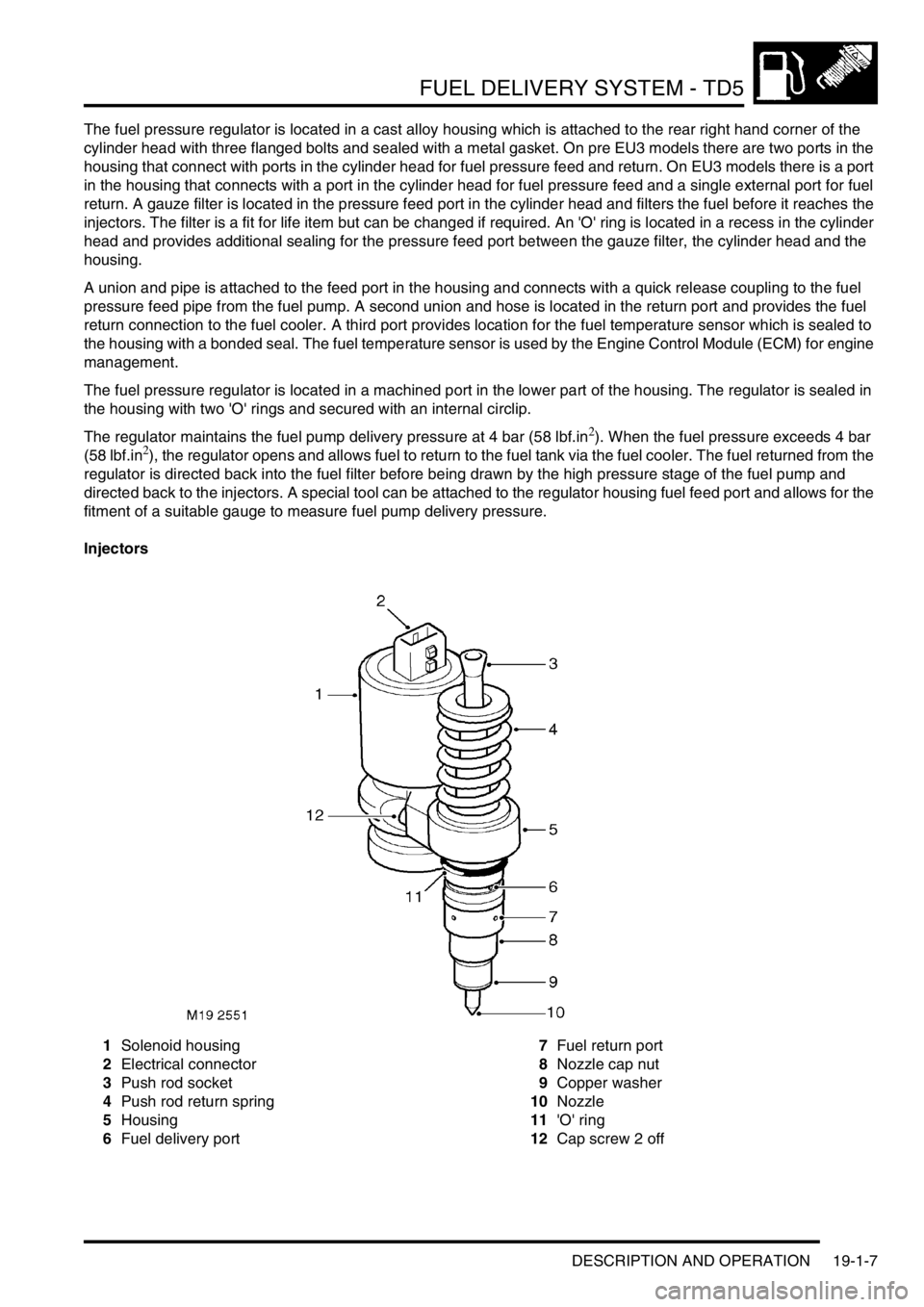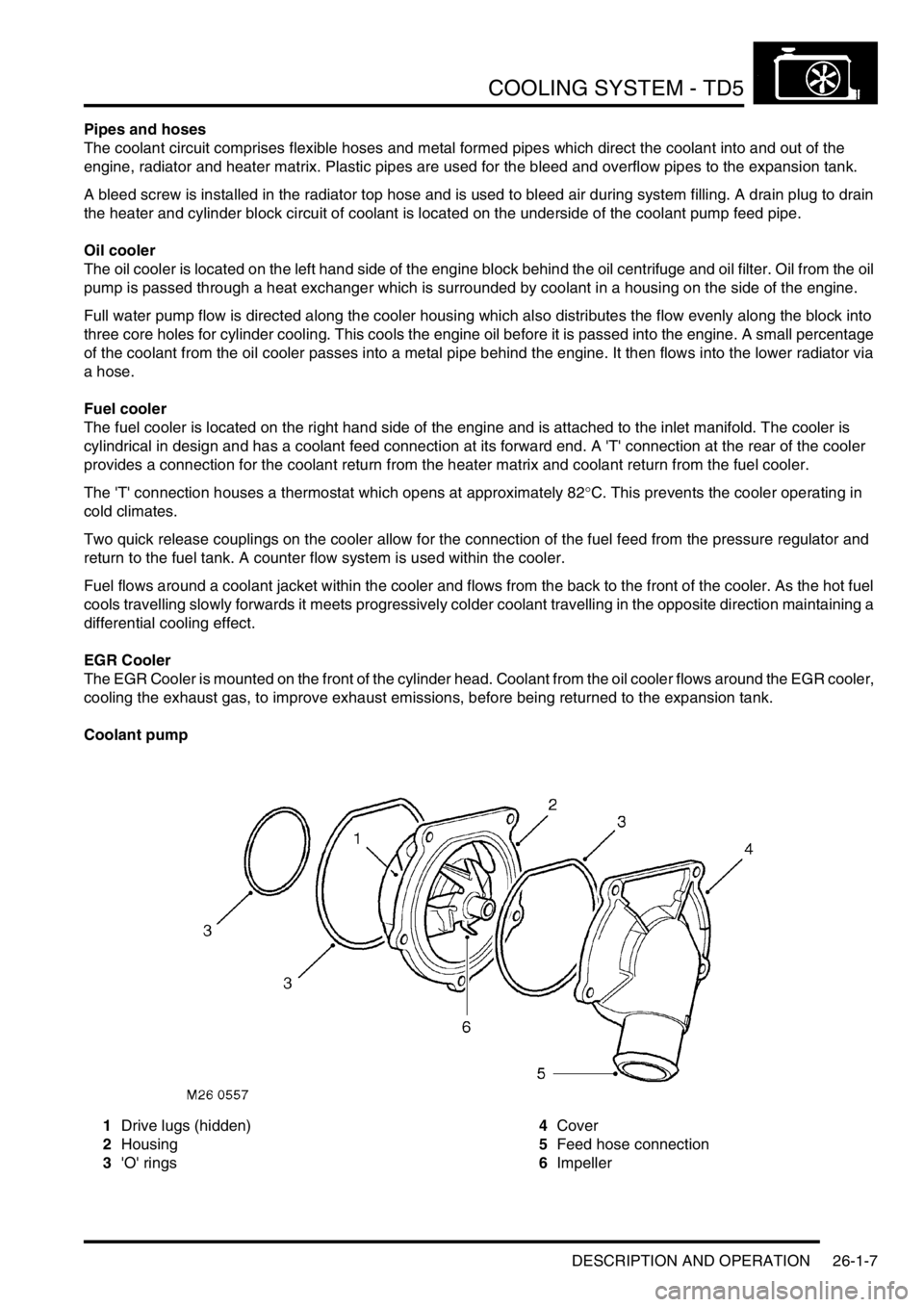open gas tank LAND ROVER DISCOVERY 2002 Workshop Manual
[x] Cancel search | Manufacturer: LAND ROVER, Model Year: 2002, Model line: DISCOVERY, Model: LAND ROVER DISCOVERY 2002Pages: 1672, PDF Size: 46.1 MB
Page 38 of 1672

GENERAL INFORMATION
03-3
Environmental Precautions
General
This section provides general information which can
help to reduce the environmental impacts from the
activities carried out in workshops.
Emissions to air
Many of the activities that are carried out in
workshops emit gases and fumes which contribute to
global warming, depletion of the ozone layer and/or
the formation of photochemical smog at ground
level. By considering how the workshop activities are
carried out, these gases and fumes can be
minimised, thus reducing the impact on the
environment.
Exhaust fumes
Running car engines is an essential part of workshop
activities and exhaust fumes need to be ventilated to
atmosphere. However, the amount of time engines
are running and the position of the vehicle should be
carefully considered at all times, to reduce the
release of poisonous gases and minimise the
inconvenience to people living nearby.
Solvents
Some of the cleaning agents used are solvent based
and will evaporate to atmosphere if used carelessly,
or if cans are left unsealed. All solvent containers
should be firmly closed when not needed and
solvent should be used sparingly. Suitable
alternative materials may be available to replace
some of the commonly used solvents. Similarly,
many paints are solvent based and the spray should
be minimised to reduce solvent emissions.
Refrigerant
It is illegal to release any refrigerants into the
atmosphere. Discharge and replacement of these
materials from air conditioning units should only be
carried out using the correct equipment.
Checklist
Always adhere to the following.
Engines:
ldon't leave engines running unnecessarily;
lminimise testing times and check where the
exhaust fumes are being blown.
Materials:
lkeep lids on containers of solvents;
lonly use the minimum quantity;
lconsider alternative materials;
lminimise over-spray when painting. Gases:
luse the correct equipment for collecting
refrigerants;
ldon't burn rubbish on site.
Discharges to water
Most sites will have two systems for discharging
water: storm drains and foul drains. Storm drains
should only receive clean water, foul drains will take
dirty water.
The foul drain will accept many of the normal waste
waters such as washing water, detergents and
domestic type wastes, but oil, petrol, solvent, acids,
hydraulic oil, antifreeze and other such substances
should never be poured down the drain. If in any
doubt speak to the Water Company first.
Every precaution must be taken to prevent spillage of
oil, fuel, solvents etc. reaching the drains. All
handling of such materials must take place well away
from the drains and preferably in an area with a kerb
or wall around it, to prevent discharge into the drain.
If a spillage occurs it should be soaked up
immediately. Having a spill kit available will make
this easier.
Additional precautions
Check whether the surface water drains are
connected to an oil water separator, this could
reduce the pollution if an incident was to occur. Oil
water separators do need regular maintenance to
ensure effectiveness.
Checklist
Always adhere to the following.
Disposal:
lnever pour anything down a drain without first
checking that it is environmentally safe to do so,
and that it does not contravene any local
regulations or bye-laws;
l have oil traps emptied regularly.
Spillage prevention:
lstore liquids in a walled area;
lmake sure that taps on liquid containers are
secure and cannot be accidentally turned on;
lprotect bulk storage tanks from vandalism by
locking the valves;
ltransfer liquids from one container to another in
an area away from open drains;
lensure lids are replaced securely on containers;
lhave spill kits available near to points of storage
and handling of liquids.
Page 552 of 1672

FUEL DELIVERY SYSTEM - TD5
DESCRIPTION AND OPERATION 19-1-7
The fuel pressure regulator is located in a cast alloy housing which is attached to the rear right hand corner of the
cylinder head with three flanged bolts and sealed with a metal gasket. On pre EU3 models there are two ports in the
housing that connect with ports in the cylinder head for fuel pressure feed and return. On EU3 models there is a port
in the housing that connects with a port in the cylinder head for fuel pressure feed and a single external port for fuel
return. A gauze filter is located in the pressure feed port in the cylinder head and filters the fuel before it reaches the
injectors. The filter is a fit for life item but can be changed if required. An 'O' ring is located in a recess in the cylinder
head and provides additional sealing for the pressure feed port between the gauze filter, the cylinder head and the
housing.
A union and pipe is attached to the feed port in the housing and connects with a quick release coupling to the fuel
pressure feed pipe from the fuel pump. A second union and hose is located in the return port and provides the fuel
return connection to the fuel cooler. A third port provides location for the fuel temperature sensor which is sealed to
the housing with a bonded seal. The fuel temperature sensor is used by the Engine Control Module (ECM) for engine
management.
The fuel pressure regulator is located in a machined port in the lower part of the housing. The regulator is sealed in
the housing with two 'O' rings and secured with an internal circlip.
The regulator maintains the fuel pump delivery pressure at 4 bar (58 lbf.in
2). When the fuel pressure exceeds 4 bar
(58 lbf.in2), the regulator opens and allows fuel to return to the fuel tank via the fuel cooler. The fuel returned from the
regulator is directed back into the fuel filter before being drawn by the high pressure stage of the fuel pump and
directed back to the injectors. A special tool can be attached to the regulator housing fuel feed port and allows for the
fitment of a suitable gauge to measure fuel pump delivery pressure.
Injectors
1Solenoid housing
2Electrical connector
3Push rod socket
4Push rod return spring
5Housing
6Fuel delivery port7Fuel return port
8Nozzle cap nut
9Copper washer
10Nozzle
11'O' ring
12Cap screw 2 off
Page 589 of 1672

COOLING SYSTEM - TD5
26-1-6 DESCRIPTION AND OPERATION
Outlet housing
A cast aluminium outlet housing is attached to the cylinder head with three bolts and sealed with a gasket. Coolant
leaves the engine through the outlet housing and is directed through a hose to the heater matrix, the radiator or the
by-pass circuit.
An Engine Coolant Temperature (ECT) sensor is installed in a threaded port on the side of the outlet housing. The
sensor monitors coolant temperature emerging from the engine and sends signals to the Engine Control Module
(ECM) for engine management and temperature gauge operation.
+ ENGINE MANAGEMENT SYSTEM - Td5, DESCRIPTION AND OPERATION, Description.
Expansion tank
The expansion tank is located in the engine compartment. The tank is made from moulded plastic and attached to
brackets on the right hand inner wing. A maximum coolant when cold level is moulded onto the tank.
Excess coolant created by heat expansion is returned to the expansion tank from the radiator bleed pipe at the top of
the radiator. An outlet pipe is connected into the coolant pump feed hose and replaces the coolant displaced by heat
expansion into the system when the engine is cool.
The expansion tank is fitted with a sealed pressure cap. The cap contains a pressure relief valve which opens to allow
excessive pressure and coolant to vent through the overflow pipe. The relief valve is open at a pressure of 1.4 bar (20
lbf.in
2) and above.
Heater matrix
The heater matrix is fitted in the heater assembly inside the passenger compartment. Two pipes pass through the
bulkhead into the engine compartment and provide coolant flow to and from the matrix. The pipes from the bulkhead
are connected to the matrix, sealed with 'O' rings and clamped with circular rings.
The matrix is constructed from aluminium with two end tanks interconnected with tubes. Aluminium fins are located
between the tubes and conduct heat from the hot coolant flowing through the tubes. Air from the heater assembly is
warmed as it passes through the matrix fins. The warm air is then distributed in to the passenger compartment as
required.
+ HEATING AND VENTILATION, DESCRIPTION AND OPERATION, Description.
When the engine is running, coolant from the engine is constantly circulated through the heater matrix.
Radiator
The 44 row radiator is located at the front of the vehicle in the engine compartment. The cross flow type radiator is
manufactured from aluminium with moulded plastic end tanks interconnected with tubes. The bottom four rows are
separate from the upper radiator and form the lower radiator for the fuel cooler. Aluminium fins are located between
the tubes and conduct heat from the hot coolant flowing through the tubes, reducing the coolant temperature as it
flows through the radiator. Air intake from the front of the vehicle when moving carries the heat away from the fins.
When the vehicle is stationary, the viscous fan draws air through the radiator fins to prevent the engine from
overheating.
Two connections at the top of the radiator provide for the attachment of the top hose from the outlet housing and bleed
pipe to the expansion tank. Three connections at the bottom of the radiator allow for the attachment of the bottom
hose to the thermostat housing and the return hose from the oil cooler and the feed hose to the fuel cooler.
The bottom four rows of the lower radiator are dedicated to the fuel cooler. The upper of the two connections at the
bottom of the radiator receives coolant from the oil cooler. This is fed through the four rows of the lower radiator in a
dual pass and emerges at the lower connection. The dual pass lowers the coolant temperature by up to 24
°C before
being passed to the fuel cooler.
Two smaller radiators are located in front of the cooling radiator. The upper radiator is the intercooler for the air intake
system and the lower radiator provides cooling of the gearbox oil.
+ EMISSION CONTROL - Td5, DESCRIPTION AND OPERATION, Emission Control Systems.
+ MANUAL GEARBOX - R380, DESCRIPTION AND OPERATION, Description.
+ AUTOMATIC GEARBOX - ZF4HP22 - 24, DESCRIPTION AND OPERATION, Description.
Page 590 of 1672

COOLING SYSTEM - TD5
DESCRIPTION AND OPERATION 26-1-7
Pipes and hoses
The coolant circuit comprises flexible hoses and metal formed pipes which direct the coolant into and out of the
engine, radiator and heater matrix. Plastic pipes are used for the bleed and overflow pipes to the expansion tank.
A bleed screw is installed in the radiator top hose and is used to bleed air during system filling. A drain plug to drain
the heater and cylinder block circuit of coolant is located on the underside of the coolant pump feed pipe.
Oil cooler
The oil cooler is located on the left hand side of the engine block behind the oil centrifuge and oil filter. Oil from the oil
pump is passed through a heat exchanger which is surrounded by coolant in a housing on the side of the engine.
Full water pump flow is directed along the cooler housing which also distributes the flow evenly along the block into
three core holes for cylinder cooling. This cools the engine oil before it is passed into the engine. A small percentage
of the coolant from the oil cooler passes into a metal pipe behind the engine. It then flows into the lower radiator via
a hose.
Fuel cooler
The fuel cooler is located on the right hand side of the engine and is attached to the inlet manifold. The cooler is
cylindrical in design and has a coolant feed connection at its forward end. A 'T' connection at the rear of the cooler
provides a connection for the coolant return from the heater matrix and coolant return from the fuel cooler.
The 'T' connection houses a thermostat which opens at approximately 82
°C. This prevents the cooler operating in
cold climates.
Two quick release couplings on the cooler allow for the connection of the fuel feed from the pressure regulator and
return to the fuel tank. A counter flow system is used within the cooler.
Fuel flows around a coolant jacket within the cooler and flows from the back to the front of the cooler. As the hot fuel
cools travelling slowly forwards it meets progressively colder coolant travelling in the opposite direction maintaining a
differential cooling effect.
EGR Cooler
The EGR Cooler is mounted on the front of the cylinder head. Coolant from the oil cooler flows around the EGR cooler,
cooling the exhaust gas, to improve exhaust emissions, before being returned to the expansion tank.
Coolant pump
1Drive lugs (hidden)
2Housing
3'O' rings4Cover
5Feed hose connection
6Impeller